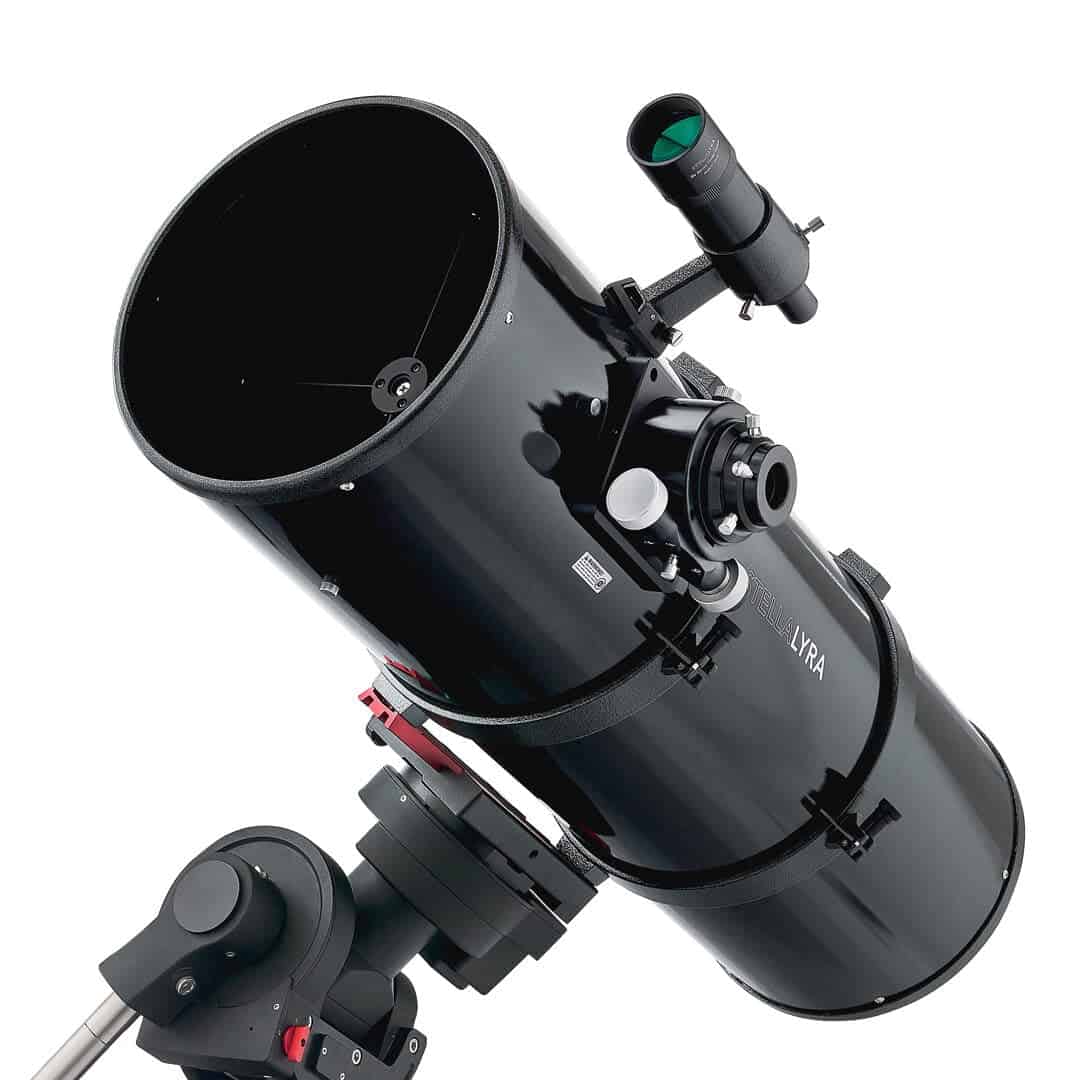The Newtonian reflector telescope, also referred to as the Newton reflector, is the original variant of the reflector telescope, created by Sir Isaac Newton in 1668. This particular design employs a primary concave mirror along with an additional flat diagonal mirror. The Newtonian telescope is well-liked for its straightforward yet efficient design, which is highly regarded by amateur telescope producers. These telescopes can now be found in various configurations and may sometimes incorporate supplementary optical components to enhance image quality or mechanically refine image positioning.
What is the functioning principle of a Newtonian telescope?
Sir Isaac Newton was the original creator of the mirrors used in a Newtonian telescope. He achieved this by combining copper and tin to form a mirror that reflected a large amount of light. This new mirror material was more affordable compared to the silver that was commonly used at that time. The telescope was specifically designed to capture light from the top of the tube, which is pointed towards the sky.
The lower part of the telescope structure contains a parabolic or spherical primary mirror. This mirror is responsible for capturing the light emitted by celestial bodies. The light, or image, that is captured by the primary mirror is then redirected and reflected towards a flat secondary mirror. The secondary mirror then reflects the image into an eyepiece. The eyepiece is usually positioned at a 90-degree angle from the secondary mirror inside the tube. It is at the eyepiece where magnification and focusing of the image occur.
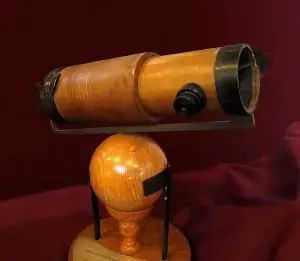
Newtonian telescope
The construction of a Newtonian telescope
Advantages of the Newtonian telescope
- This specific design of telescope offers image formation without chromatic aberrations, unlike other refractor telescopes.
- Newtonian telescopes are generally more affordable compared to other telescopes with a similar configuration for any given lens diameter (or aperture).
- The manufacturing process for these telescopes is not complicated. They only require one surface to be ground and polished to a complex shape. Early designs of reflector telescopes, such as Gregorian and Cassegrain, required two surfaces to be imaged. Achromatic reflector telescope lenses had four surfaces to be imaged.
- The wide field of view is easily achieved with the telescopic design due to its ability to obtain a short focal length.
- By placing the eyepiece on the upper end of the telescope, this design creates a compact mounting system that enhances portability and reduces cost.
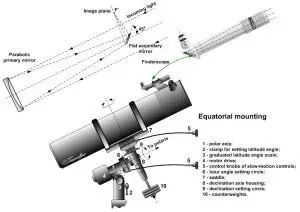
Here we have a commercial Newtonian telescope.
The drawbacks of the Newtonian telescope
- Similar to other reflectors, the Newtonian telescope is susceptible to coma. Coma refers to off-axis aberration, which causes images to appear to converge inward towards the optical axis. (Stars at the edge of the field of view have a “comet-like” shape.) The amount of visible convergence increases in proportion to the field of view angle and inversely with the square of the mirror’s focal length ratio (the ratio between the mirror’s focal length and diameter).
- The formula for the third-order tangential coma is 3θ / 16F², where θ represents the off-axis angle (in radians) of the formed image, and F represents the focal ratio. When the focal length of a Newtonian telescope is f / 6 or less, it is considered to have significant coma for visual or photographic purposes. By combining primary mirrors with low focal ratios and coma-correcting lenses, the image quality can be improved across the entire field.
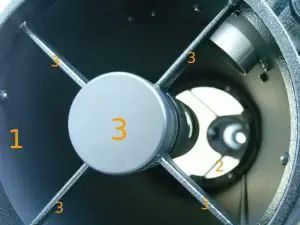
A depiction of a Newtonian optical assembly is shown, including a tube, a primary mirror, and a spider support or secondary diagonal mirror support.
- Collimation can be a challenge with portable Newtonian reflectors. Transporting and handling the telescopes can cause the primary and secondary mirrors to become misaligned. This requires the additional task of readjusting or collimating the entire telescope each time it is moved. Some telescope designs, such as refractors and catadioptric telescopes (especially Maksutov-Cassegrains), have solved this issue.
- This unique design positions the focal plane at a non-symmetrical point at the highest part of the optical tube assembly. As a result, the eyepiece is situated in a less optimal viewing position, particularly when the telescope is mounted on an equatorial mount. In fact, larger telescopes often necessitate the use of ladders or other elevated structures to access the eyepiece. Some designs incorporate a mechanism to rotate either the eyepiece mount or the entire tube assembly in order to achieve a more favorable viewing position. Properly balancing these weighty instruments at the focal plane is crucial for scientific research purposes.
Modified Newtonian Telescope:
Jones-Bird Reflector
The Jones-Bird Reflector Telescope, also known as the Jones-Bird, is a variation of the Newtonian design that incorporates a catadioptric (mirror-lens) system. Unlike the traditional Newtonian telescope, which utilizes a parabolic mirror, the Jones-Bird design features a spherical main mirror. To correct for spherical aberrations, a subaperture corrector lens is employed, either positioned in front of the secondary mirror or within the telescope tube. This design offers the advantage of reducing the overall size and cost of the telescope, as well as significantly shortening the length of the telescope tube.
Schmidt-Newton telescopes
One type of telescope that incorporates a correction plate is the Schmidt-Newton telescope. By placing a correction plate in front of the telescope, a closed tube system is created, ensuring that the air inside the tube remains constant and helps to maintain a constant temperature inside. Furthermore, this plate is able to detect and correct any errors or aberrations that may arise from the telescope’s primary mirror. Additionally, the design of the Schmidt-Newton telescope ensures that the secondary mirror is positioned behind the plate, preventing any interference from the cross support in the formation of images.
As mentioned in a previous post, there are various types, or systems, of telescopes. When browsing through astronomical stores, the abundance of names for these systems can be overwhelming – including Maksutov, Newton, Klevtsov, Schmidt-Kassergren, Dobson, Ritchie-Kretien, and many more. However, there’s no need to panic just yet! In reality, all of these systems can be neatly categorized into three groups: refractors, reflectors, and catadioptrics. So, how do they differ from one another? Let me explain.
A telescope that most people envision when they think of the word “telescope” is called a refractor. It consists of a long tube with a lens at one end and an eyepiece at the other. The primary advantage of a refractor is that there are no obstructions in the path of light from the lens to the observer’s eye. As a result, the image produced by refractors has exceptional contrast, surpassing that of other telescope types. Refractors also require less maintenance, especially in terms of alignment (also known as collimation). Additionally, they are more resistant to temperature changes, allowing them to stabilize faster than reflectors when transitioning from indoor to outdoor environments.
Thanks to its high contrast, the refractor provides the clearest and most detailed view of the Moon and planets. This is particularly true when observing under less than ideal conditions, as a larger telescope aperture will cause image blurring due to atmospheric turbulence. The image in a smaller refractor will be less affected by this. Additionally, since the Moon and planets are brightly illuminated by the Sun, high magnification is more important than light gathering when observing these objects (a unique scenario!). In this situation, the smaller aperture of refractors is advantageous because, at high magnification, the brightness from the planet’s surface will not obscure the fainter details.
Therefore, a refractor with an alt-azimuth design and a precision movement system is excellent for studying the Moon, planets, binary stars, and scattered clusters. When observing as a group, it is advisable to use a motorized equatorial mount, as it allows for continuous tracking of the chosen object in the center of the field of view. Additionally, for terrestrial observations during the day, a refractor mounted on an alt-azimuth mount is also highly effective.
What are the drawbacks of a refractor telescope? With the exception of apochromat telescopes (which are quite costly), all refractors experience chromatic aberration, resulting in a slight purple fringing around bright stars, planets, and the Moon. To minimize this effect during observations, special filters are employed. Another significant disadvantage is that as the aperture size increases to 100 mm and beyond, refractors become heavier and more expensive compared to reflectors. However, disregarding these drawbacks, a well-made refractor is an excellent tool for astronomers who enjoy observing celestial objects. Even when studying faint nebulae, the high image contrast of a refractor can more than make up for the lack of aperture, especially when compared to a reflector in the same price range.
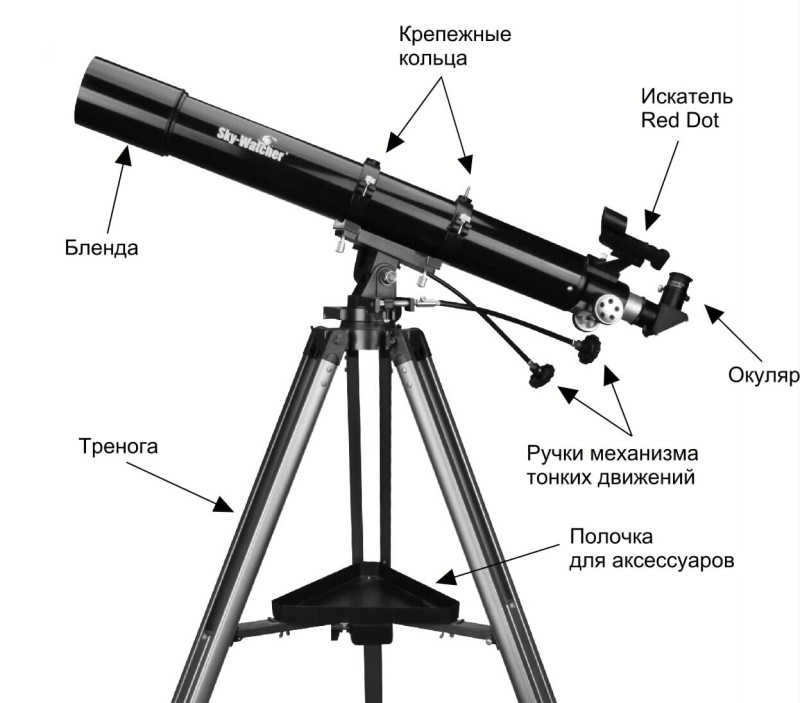
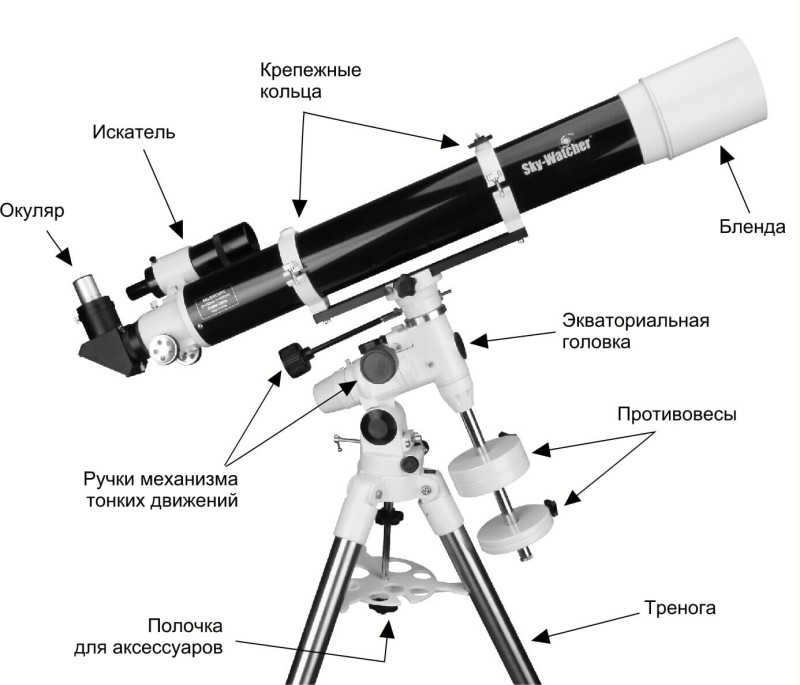
Advantages and disadvantages of reflectors
What is the purpose of purchasing a reflector? The main advantage is its affordability. A Newtonian reflector provides more value for the money spent compared to other types of telescopes. Why is this so? Well, the manufacturing process for a reflector involves polishing only one surface with complex curvature to an incredibly high level of precision. In contrast, producing a refractor lens requires polishing up to four surfaces to the same level of precision. The optical configuration with one parabolic and one flat mirror is the least expensive option, resulting in the lowest cost per centimeter of aperture. Consequently, a reflector will offer the largest aperture for the same amount of money when compared to other telescope designs. And, as we have mentioned before, the larger the aperture, the higher the optical power of the instrument.
The Newton reflector utilizes a parabolic mirror positioned at the base of the tube to gather light and redirect it towards a focal point at the top of the tube. At this focal point, a small secondary mirror redirects the image into an eyepiece located on the side. For inexperienced observers, it can be challenging to adjust to the concept of observing “from the side” and in close proximity to the entrance hole of the tube. However, in practice, this approach is quite convenient, with the only drawback being the inability to observe the overall view of the sky “above” the telescope, as refractor owners often do.
The reflector’s wide aperture enables capturing bright images of faint deep space objects, surpassing the capabilities of smaller refractors, particularly in optimal observing conditions away from city lights. Acquiring a reflector on a Dobsonian mount proves highly advantageous, both financially and in terms of performance for observing deep space objects. The Dobsonian mount, featuring a large-diameter main mirror and a cost-effective wooden altazimuthal mount, has revolutionized amateur astronomy. Without a doubt, Dobsonian reflectors stand out as aperture record-breakers among amateur telescopes.
However, every item in this world has a price tag. To begin with, a reflector with a large aperture is a bulky and hefty instrument. When making a decision on a reflector, keep in mind that it is not a walk in the park to maneuver a 40-kilogram construction with a tube that stretches one and a half meters long, so for a child, a reflector may not be the optimal choice. The second drawback of reflectors is the dispersion of light caused by the secondary mirror. This diminishes the sharpness of the image, particularly when observing the Moon and planets, thus reflectors often fall behind refractors in terms of capturing intricate details.
The third point. Coma, an optical defect (aberration), can be found in all refractors without exception due to the curvature of the main mirror. This defect causes the stars at the edges of the field of view to appear more or less stretched out. However, this does not significantly impact visual observations as astronomers typically focus on objects in the center of the field of view, where the image remains undistorted. Reflectors, on the other hand, especially when frequently transported, require periodic alignment to ensure the mirrors are properly aligned. Additionally, the open design of the tube makes reflectors susceptible to dust accumulation on the main mirror, requiring regular cleaning.
Despite the aforementioned disadvantages, the Newton reflector is still the preferred choice for serious visual observations of faint galaxies and nebulae.
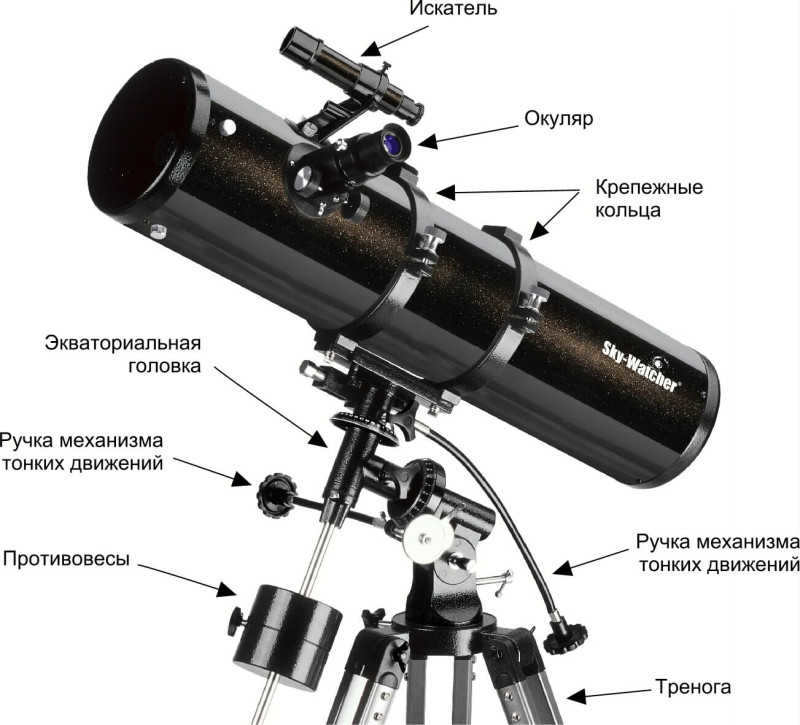
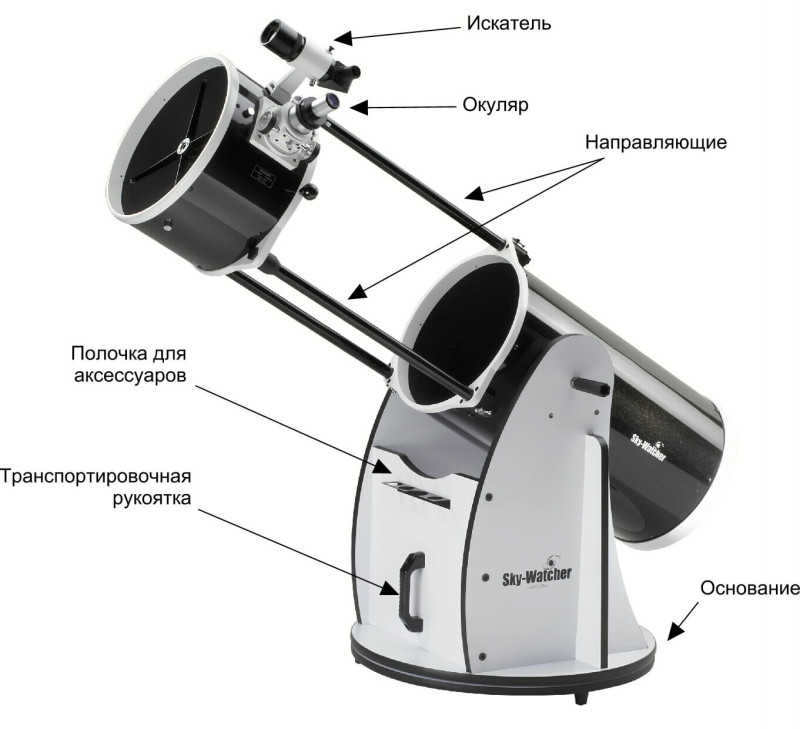
Advantages and Disadvantages of Catadioptric Telescopes
What are the pros of mirror-lens systems? Firstly, their compact size. The combination of special lenses and mirrors allows for the telescope tube to be rolled up into a portable and convenient design. If you enjoy “astronomical tourism” or have limited storage space in your apartment, a catadioptric telescope is the ideal choice. This type of telescope resembles a refractor, with a front lens and an eyepiece at the back, but its tube is significantly shorter than that of a refractor with the same aperture. It is the only kind of telescope that can easily fit into a regular sports bag (with a 90 mm aperture) or a backpack for tourists (with a 200 mm aperture), along with all the necessary accessories.
Another advantage of catadioptrics is the superior quality of the images they produce. Unlike reflectors, they are virtually free from coma, and unlike refractors, they do not suffer from chromatic aberration. When using a mirror-lens telescope, the images of stars will be crystal clear throughout the entire field of view, without any distortion or colored halo. Additionally, this type of optical system does not need frequent alignment, and its closed tube design provides protection for the main mirror against dust.
What are the drawbacks of these telescopes? Initially, the diffusing of light on the secondary mirror leads to a reduced contrast of the image compared to refractors. Additionally, the expensive production of large-diameter correcting lenses results in mirror-lens telescopes with higher power being considerably pricier than reflectors of the same size. Nonetheless, when the compactness of the tube and ease of transportation, along with superb image quality, are crucial, any other disadvantages of mirror-lens telescopes become insignificant.
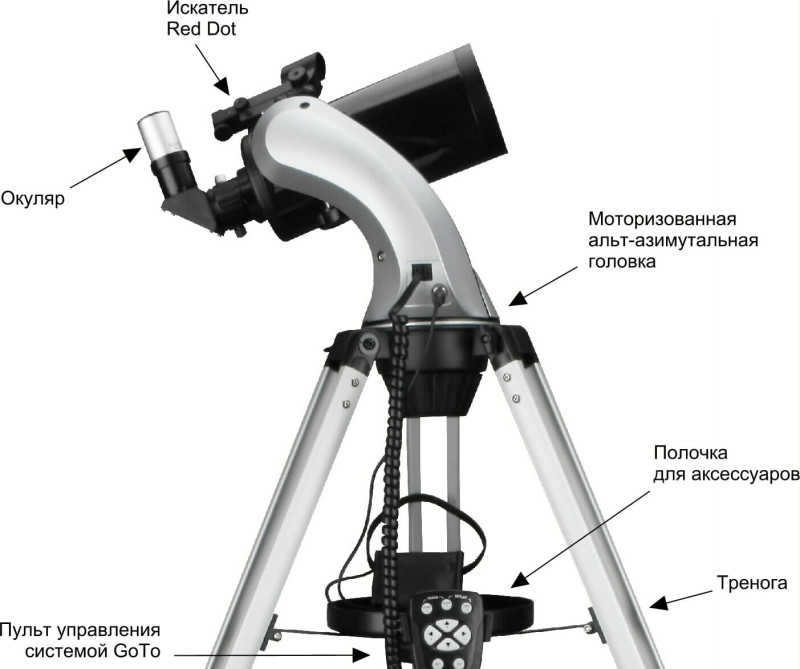
A few additional recommendations
- Don’t overspend on size. It’s important to choose a telescope with a weight that can be easily carried to the yard or balcony. This is especially important when selecting a telescope for a student. Advertisements may describe a telescope as “compact and lightweight”, but it could actually weigh 20 kilograms, which is too heavy for a child or teenager.
- If you plan on transporting the telescope in a car, make sure that the size of the tube allows it to fit inside the cabin or trunk. Otherwise, you may find yourself needing a small truck in addition to your telescope.
- Take into account the scale of your astronomical aspirations and consider the size of the telescope and the proximity of the nearest observation site. A 250mm telescope will be ineffective in the midst of a polluted city, and venturing outside of town with a half-meter telescope weighing half a centner requires a certain level of determination.
- Don’t exhaust your entire planned budget on the telescope alone. Set aside some funds to invest in eyepieces, filters, and other essential supplementary equipment.
- Make it a priority to observe as frequently as possible. When the weather permits, aim to dedicate at least one hour each evening to observation. This won’t significantly interfere with your favorite TV shows or the national soccer championship.
- Develop your ability to see by regularly observing the same objects. With each observation, you’ll start to notice increasingly intricate details.
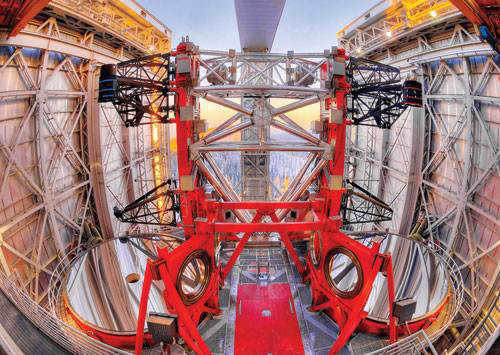
Telescopes hold a unique position among scientific instruments. In the early 20th century, scientific experiments could be conducted with instruments that fit on a laboratory table or two, but telescopes, in their early days, grew to be dozens of meters long. Image: Popular Mechanics
The largest telescopes of today are massive structures equipped with advanced detector systems and tools for correcting light distortion. However, their fundamental optical designs were largely developed in the 17th century. In this sense, telescopes are quite conservative instruments, even though they now feature cutting-edge technology such as gigapixel digital sensors, high-resolution spectrographs, and computerized correction of atmospheric wavefront distortions. Nonetheless, optical telescopes have made tremendous progress over the course of four centuries.
Dutch trumpets
The initial telescopes were replicas of telescopes created by Dutch craftsmen during the early 17th century. These telescopes utilized only two lenses – a convex lens for long-focus objectives and a concave lens for short-focus eyepieces. This design produced a straight image, without inversion, that offered maximum clarity. The length of the tube, which corresponded to the difference in focal lengths between the lens and eyepiece, determined the magnification of the telescope.
Harriot’s initial telescope provided a magnification of six times. Later on, the scientist created additional tubes, increasing the magnification to 20-30x. With these tools, he conducted detailed observations of sunspots and accurately determined the length of the solar day. Unfortunately, Harriot chose not to publish his numerous scientific works, which could have brought him fame during his lifetime. He conducted groundbreaking algebraic studies far ahead of his time and also discovered the law of light refraction prior to Willebrod Snellius and René Descartes (it is possible that this law was already known to the 10th-century Baghdad scholar Ibn Sahl; in any case, one of the drawings in his recently discovered treatise On Burning Mirrors and Lenses indicates this). The fact that Harriot was the first astronomer to use telescopes is still relatively unknown today.
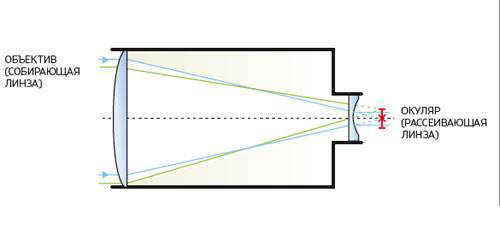
Galileo’s Refractor
This refractor telescope designed by Galileo Galilei utilizes a converging lens as the objective and a diverging lens as the eyepiece. This type of telescope produces an image that is not inverted, but it has a limited field of view and the image appears dim. Image: “Popular Mechanics”
Nevertheless, Harriot’s monopoly was short-lived. In autumn 1609, the renowned Italian scientist Galileo Galilei and the German astronomer Simon Marius turned their instruments skyward. Marius utilized a pre-made Dutch trumpet, while Galileo Galilei honed his skills in lens grinding and crafted four trumpets himself, with the largest believed to provide over 30 times magnification. In March 1610, he published the book Sidereus nuncius (“Starry Messenger”), detailing his telescopic observations of the Moon, Jupiter, and the Milky Way (specifically, he discovered the four largest satellites of Jupiter in January, although Marius later claimed to have done so slightly earlier). It was through this work that scientists (and indeed the entire educated public) became aware of the possibilities that telescopes unlocked. Thus, Galileo ushered in the field of optical astronomy as a new frontier in the study of celestial phenomena. In commemoration of this momentous occasion, we are currently celebrating the International Astronomical Year.
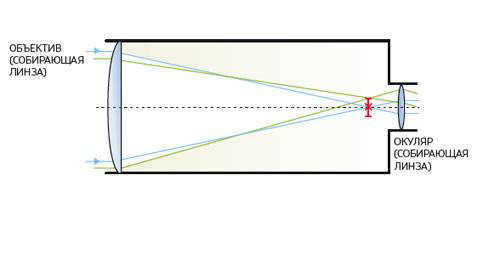
Kepler’s refractor
Kepler put forward his own design for a refractor in 1611, which featured two lenses for collecting light. One lens acted as an objective, while the other served as an eyepiece. This design had a wider field of view compared to Galileo’s and resulted in a brighter image, although it was inverted. Image: Popular Mechanics
Scheiner introduced a significant enhancement. He hypothesized that a telescope could be directed to a specific area in the sky by rotating it along two perpendicular axes, one of which is aligned perpendicular to the equatorial plane. In the 1620s, he proposed a prototype of the equatorial mount (refer to the box), which greatly simplified the compensation for the Earth’s daily rotation. Although the principle was not entirely new at the time (in 1585, Danish astronomer Tycho Brahe employed the same technique to mount his largest angular-measuring instrument, a large armillary sphere), Scheiner was the first to utilize it for telescope aiming. The system was further refined by another Jesuit astronomer, Christopher Greenberger, and in the 1670s, Robert Hooke suggested incorporating a clockwork mechanism to facilitate the rotation of the telescope.
This is our current position
A mount is a device that allows a telescope to be securely positioned. Mounts are categorized based on the arrangement of perpendicular axes that the telescope rotates around during aiming.
There are two primary types of mounts: equatorial and alt-azimuthal. In an equatorial mount, one of the telescope’s rotation axes is parallel to the Earth’s axis (and perpendicular to the equator). This axis, known as the hour or polar axis, is responsible for compensating for the Earth’s rotation by completing a full revolution in 23 hours and 56 minutes (equivalent to one sidereal day). The other axis is called the declination axis.
An alt-azimuthal mount also utilizes perpendicular rotation axes – vertical and horizontal. However, this design has a disadvantage of requiring variable-speed rotation around both axes to stabilize the telescope. Nowadays, computers easily handle this task, which is why most large modern telescopes use an alt-azimuth mount.
The arrival of mirrors
Reportedly, the initial attempt to create a reflecting telescope took place in 1616 by Niccolò Zucci, a mathematics professor from Rome who was also a Jesuit. Zucci used a concave bronze mirror and placed a concave lens in its focal point, only to find that it produced no visible results. In theory, this device had the potential to be successful if Zucci had access to a well-polished mirror, but unfortunately, such a mirror had not yet been developed. In the 1630s, Bonavertura Cavalieri from Italy and Marin Mersenne from France, both of whom were also affiliated with the church, published works that extensively analyzed the possibilities of optical devices utilizing mirrors, but they did not make any attempts to construct them.
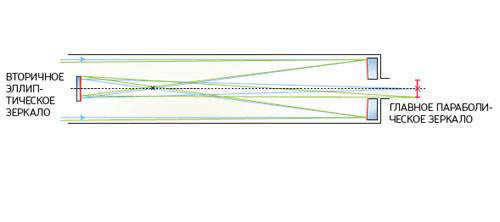

Gregory’s Reflector
The main mirror is parabolic, the secondary mirror is elliptical, and the eyepiece is positioned within the central aperture of the main mirror. Gregory’s arrangement allows for an extended focal length (and magnification) and produces a direct image. Image: Popular Mechanics
Advancements gained momentum during the latter part of the 17th century. In 1661, James Gregory, a mathematician from Scotland (who happens to be the great uncle of the previously mentioned David Gregory), proposed a highly effective blueprint for a reflector. The concept involved directing light from a distant object onto a primary focusing mirror with a surface that resembled a rotating paraboloid. The reflected rays would then be redirected onto a smaller, yet equally concave auxiliary mirror with an ellipsoidal surface positioned in front of the focal point of the parabolic reflector. Upon the second reflection, the light would pass through a central aperture in the primary mirror and be precisely focused by a convex ocular lens. In theory, this arrangement would produce a distortion-free image with no spherical aberration. Although some degree of chromatic aberration was present, it could be easily eliminated with the invention of an achromatic eyepiece (which had not yet been developed at that time). Gregory even enlisted the services of Richard Reeve to manufacture mirrors for this revolutionary telescope. Unfortunately, Reeve was unable to produce mirrors of the required caliber.
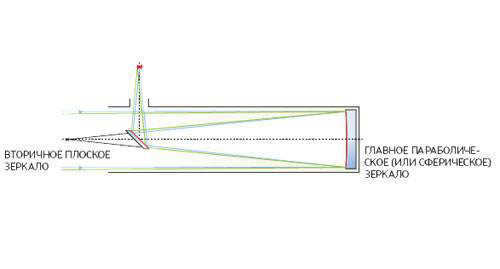

Newton’s Reflecting Telescope
Light is concentrated by a main (parabolic, at small relative aperture – spherical) mirror and redirected by a small secondary (flat) mirror outside the tube into the eyepiece. Produces an upside-down picture. Image: “Popular Mechanics”
There is a possibility that Reeve would have had the opportunity to refine the mirrors and improve them over time. However, Gregory was in a rush to travel abroad and did not want to wait, so he did not return to this project. Consequently, the first operational reflector telescope was invented and constructed in 1668 by Isaac Newton. Unlike the Gregorian telescope, the secondary mirror of Newton’s telescope is flat rather than convex. It is positioned at a 45-degree angle to the optical axis, allowing light to enter the eyepiece through a hole in the tube (thus, one does not look into the back of the telescope, but from the side). Newton achieved success by using his own technique to grind the main mirror, which involved applying abrasive powder to a resin substrate. This method resulted in a mirror that was accurate to within one-tenth of a micron. Later on, Newton created another reflector telescope and presented it to the Royal Society of London on January 11, 1672 (where he was subsequently elected as a member). A replica of this telescope, made in the 18th century and containing some original parts crafted by Newton himself, has survived to this day (as the original Newtonian reflector is believed to be lost).
Cassegrain’s invention
In the history of optical telescopes, the year 1672 stands out as a significant milestone. A member of the French Academy relayed the news to his colleagues that Laurent Cassegrain, a priest and professor from Chartres, had introduced an innovative version of the reflecting telescope. Cassegrain’s telescope shares similarities with the Gregorian and Newtonian designs, featuring a concave parabolic primary mirror with a central aperture. However, what sets it apart is the inclusion of a convex hyperboloid as the secondary reflector, positioned not in front of the main mirror’s focus, but behind it. This arrangement allows for a shorter tube length, which can be several times less than the focal length of the primary mirror.
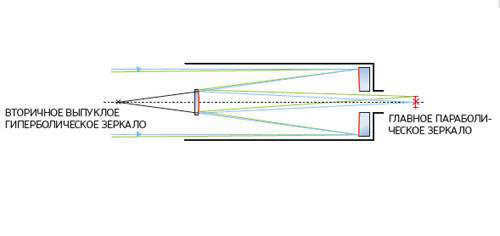
The Cassegrain reflector
The primary mirror is a concave parabolic shape, while the secondary mirror is a convex hyperbolic shape. This design allows for a reduction in the size of the telescope compared to Newton and Gregory’s designs, while maintaining the same diameter and focal length. Image: Popular Mechanics
In 1732, James Short, an Edinburgh craftsman, created the first working telescope of the Gregorian type. That same year, John Hadley, an English mathematician and the inventor of the sextant, constructed the Cassegrain telescope. By the end of the first half of the 1730s, all the traditional designs of refracting and reflecting telescopes had been put into practical use.
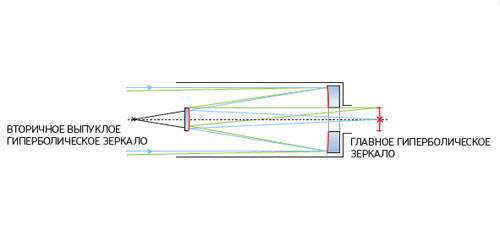
The Ritchie-Cretien reflector
A variation of the Cassegrain system using hyperbolic primary and secondary mirrors. This design corrects for coma and spherical aberration, making it one of the most widely used configurations for professional telescopes. Image: Popular Mechanics
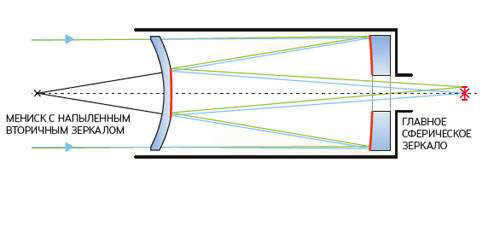
Maksutov-Kassegren
A modification of the Cassegrain system, commonly employed in the construction of small-sized telescopes utilized by amateur astronomers. The primary mirror is a concave sphere and functions as a meniscus, correcting for spherical aberration. It consists of a spherical plate, with the secondary mirror deposited on the central section of its inner surface. Image: Popular Mechanics
Centuries of Silence
Throughout the span between the 18th and 20th centuries, telescopes remained relatively unchanged. Although there were improvements in size, resolution, luminosity, and magnification, these instruments were essentially similar to their predecessors.
Nevertheless, technological advancements continued to advance. The brilliant astronomer from Britain, William Herschel, constructed the most advanced telescopes of his era. Among them was the highly esteemed “Big twenty-foot” telescope, boasting a mirror with a diameter of 47 centimeters. Herschel later built an even larger forty-foot telescope with an iron pipe and a mirror diameter of 120 cm, but unfortunately, it did not prove to be very useful due to its difficulty in handling and the mirrors deteriorating quickly. Another notable example was the largest telescope of the 19th century, completed in 1845. This six-foot aperture telescope with a 17-meter wooden tube was situated on the estate of the Irish aristocrat, William Parsons, the third Lord Ross. Although this instrument was the first to reveal the spiral structure of certain nebulae, it did not yield significant results in other areas.
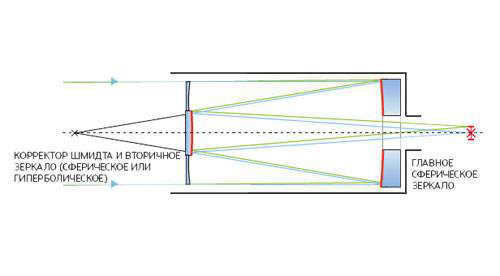

Schmidt-Kassegren
A modified version of the Cassegrain design, which is popular among high-quality amateur telescopes. The primary mirror has a concave spherical shape and is accompanied by a sophisticated lens (known as Schmidt corrector) that compensates for spherical aberration. Positioned on the inner side of the corrector is a secondary mirror, which can be either spherical or hyperbolic (to correct for coma). Image: Popular Mechanics
The second half of the 19th century is often referred to by astronomy historians as the era of the great refractors. During this time, a new generation of telescopes with lenses larger than 25 inches (63.5 cm) in diameter emerged. The initial creation of such an instrument occurred in 1862, and it was followed by the production of nine more before the turn of the century. The largest refractor of this era, which remains the largest to this day, is the 40-inch refractor located at the Yerkes Observatory. This impressive telescope has been in operation since 1897. Additionally, it is worth noting that these years also marked the emergence of the first industrial companies specializing in telescope production.
Stars without Reflection
All leading contemporary telescopes are furnished with collaborative active and adaptive optics systems. The former enables electromechanical manipulators to alter the configuration of the primary mirror in order to restore its geometrically accurate surface (and occasionally adjusts the spatial orientation of the secondary mirror as well). This guarantees that the primary mirror delivers optimal image quality regardless of the angle of the telescope tube and any variations in temperature, humidity, and wind intensity.
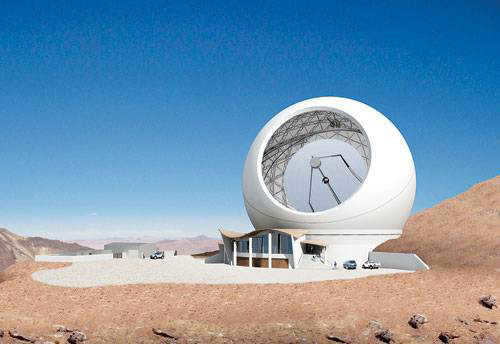
Adaptive optics is a technology that corrects for the interference caused by the atmosphere, which can cause incoming light signals to become “blurry”. This innovative system is able to detect and measure any distortions in the wavefront as it passes through the aperture, and then it compensates for these distortions by using either a deformable auxiliary mirror or a liquid crystal matrix that can be adjusted to counteract the effects of the atmosphere. In order to assess the quality of the resulting image, scientists often use bright stars with known spectra or artificial pseudo-lights, which are created by illuminating the atmosphere with a powerful laser to generate glowing sodium ions at an altitude of approximately 90 km.
Click here to watch a video related to this topic: link
During the 20th century, there was a shift towards the use of large reflectors in the field of astronomy. A significant development occurred in 1917 with the completion of the 100-inch Hooker telescope on Mount Wilson in Southern California. This telescope played a crucial role in the work of Edwin Hubble, who utilized it to determine the distance to the Andromeda Nebula and make the groundbreaking discovery of the cosmological expansion of the Universe. For several decades, the 100-inch Hooker telescope held the title of the largest telescope in the world until it was surpassed by the 200-inch Hale reflector at Mount Palomar in 1948. Both of these telescopes feature one-piece mirrors and are mounted on equatorial mounts.
The Era of Enormous Telescopes
Almost three decades after the Hale telescope was introduced, the BTA (Big Telescope Azimuthal) took the title of the largest reflector telescope. It has been operational since 1976 at the Special Astrophysical Observatory on Mount Semirodniki near Nizhny Arkhyz. The BTA is remarkable for being the first gigantic telescope to have a computerized alt-azimuth mount. Unfortunately, it did not yield any significant discoveries, partly due to its unfortunate location and partly due to the unresolved distortions caused by its excessively massive 605 cm diameter one-piece mirror.
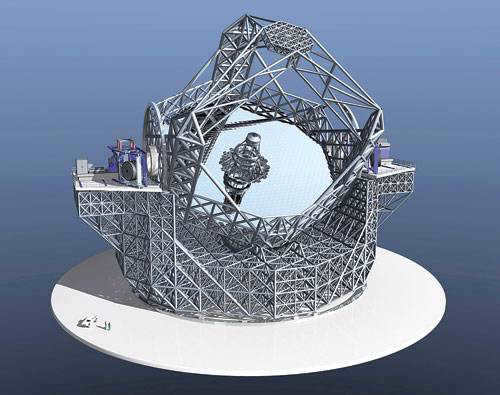
Optical behemoth
The European Southern Observatory’s (ESO) Extremely Large Telescope (E-ELT) project is set to commence construction in 2018. The E-ELT will boast a mammoth multi-segment mirror with a diameter of 42 meters, enabling unparalleled visible and infrared observations. Image courtesy of Popular Mechanics.
The nature of astronomical observation has been completely transformed by the new telescopes. The traditional image of a solitary observer spending nights in the observatory and days developing and analyzing photographic plates is no longer accurate. According to Patrick McGray, a professor at the University of California, Santa Barbara and the author of the book “Giant Telescopes: Astronomical Ambition and the Promise of Technology,” most of the work of astronomers is now done by operating engineers who use computer links to point telescopes at specific targets, take detector readings, and transmit the data to researchers. In addition to this, there are now fully automated telescopes that can be operated remotely, although they may be smaller in size. The field of “unmanned” astronomy is expected to continue evolving in the future.
In the 1990s, telescopes with even bigger monolithic mirrors didn’t make an appearance. These include the Gemini North at the Mauna Kea Mountain Observatory in Hawaii, which has an 810-centimeter mirror, and the Subaru in Japan, which has an 830-centimeter mirror (the name means “Pleiades” in Japanese). There are also four 820-centimeter instruments at the complex Very Large Telescope (VLT) of the Southern European Observatory (ESO) in Chile’s Atacama Desert. Another notable telescope is the Large Binocular Telescope (LBT) with a pair of 840-centimeter mirrors that are installed on Mount Graham in Arizona.
A groundbreaking development in telescope construction has been the utilization of cellular mirrors composed of numerous hexagonal segments. These innovative mirrors have been incorporated into telescopes boasting mirror diameters exceeding 9 meters, including the Hobby-Eberly at McDonald Observatory in Texas, the South African Large Telescope at the South African Astronomical Observatory, as well as the two identical ten-meter telescopes, Keck-1 and Keck-2, situated on Mauna Kea.
Exploring uncharted territories for colossal creatures
Now, the leader of this small family is the Gran Telescopio Canarias, which boasts a 10.4-meter mirror made up of 36 segments. Interestingly enough, this impressive modern instrument, with an aperture that surpasses the symbolic 10-meter mark, was unveiled on the beautiful Canarian island of La Palma on July 24, 2009. This date holds significance as it marks nearly four centuries since the first documented use of the telescope.
If you or your loved ones have an interest in astronomy, you may have found yourself pondering the question: How does one go about selecting the perfect telescope?
For amateur astronomers and enthusiasts alike, the task of choosing a telescope can feel overwhelming. The market offers a wide array of options, each with its own unique features and characteristics that non-experts must familiarize themselves with.
We aim to assist you in understanding the fundamental terms and features of astronomical equipment, as well as selecting a MEADE telescope suitable for beginners.
An optical telescope, or simply a telescope, is a device created for observing distant objects within the visible range of the electromagnetic spectrum. The main function of a telescope is to gather the light that enters the lens and direct it towards the observer’s eye. By using a telescope, objects can be viewed in closer proximity, appear larger, and reveal more intricate details compared to the unaided eye.
The process of choosing a telescope holds significant importance for beginners, as it largely determines the subsequent effectiveness of their astronomical observations.
A telescope is composed of three main parts: the optical tube, mount, and tripod. The optical tube contains the necessary components for image formation, while the mount is a mechanism designed to point the telescope at objects and track them. The tripod serves as the support for the mount and optical tube.
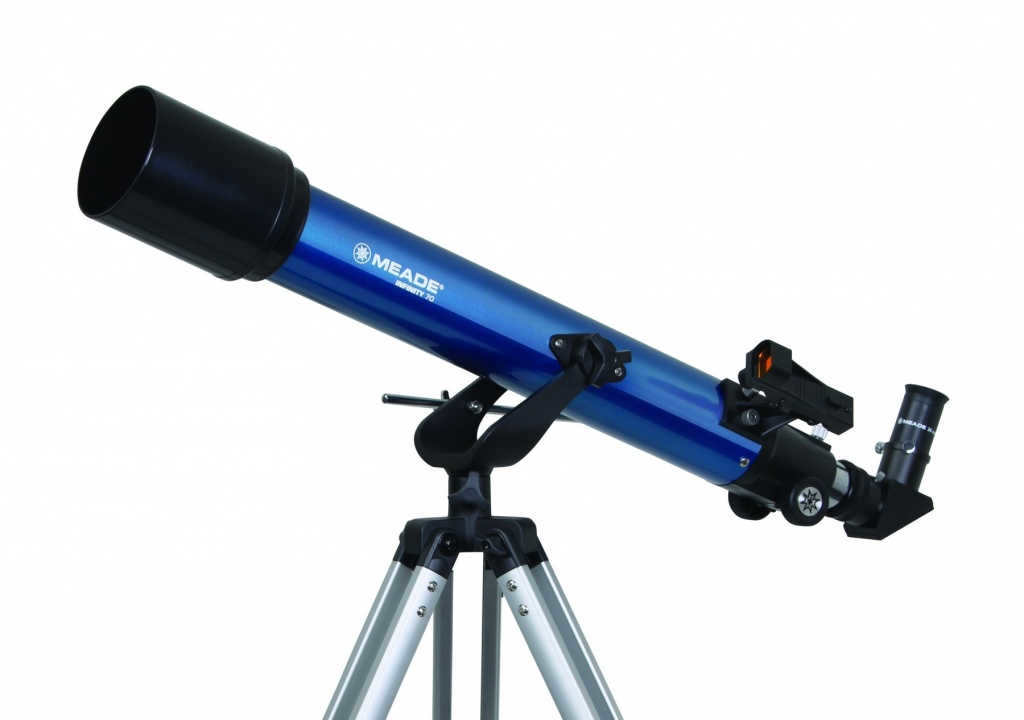 | 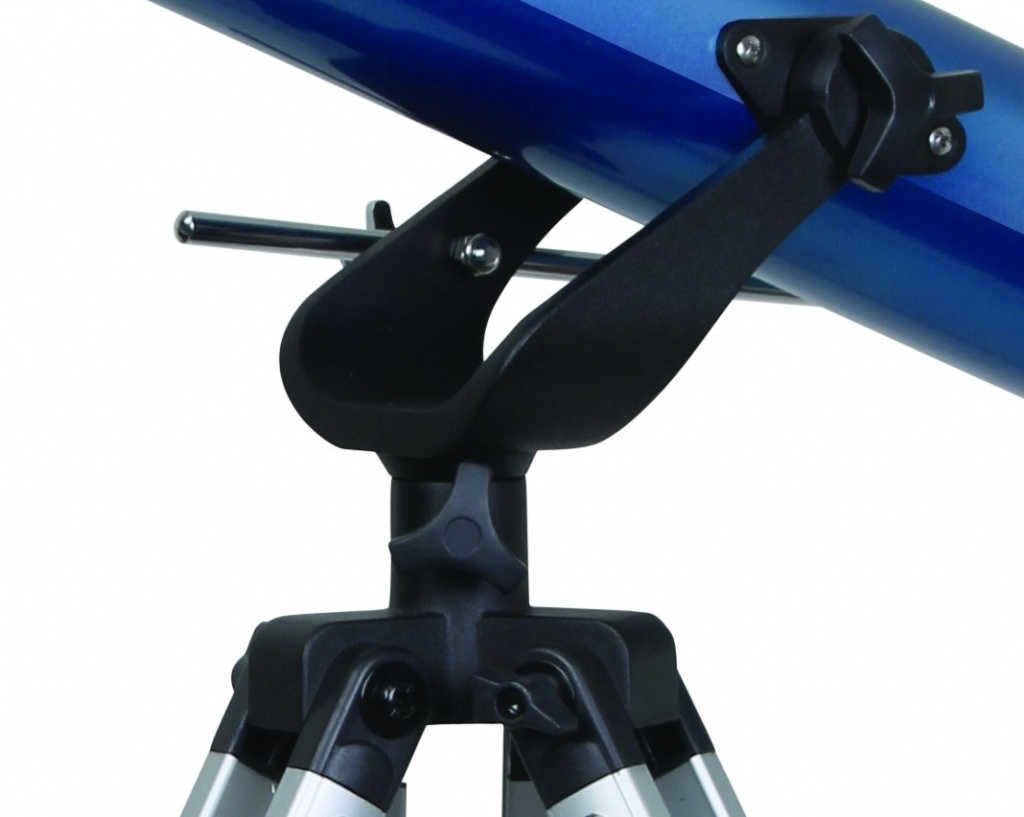 | 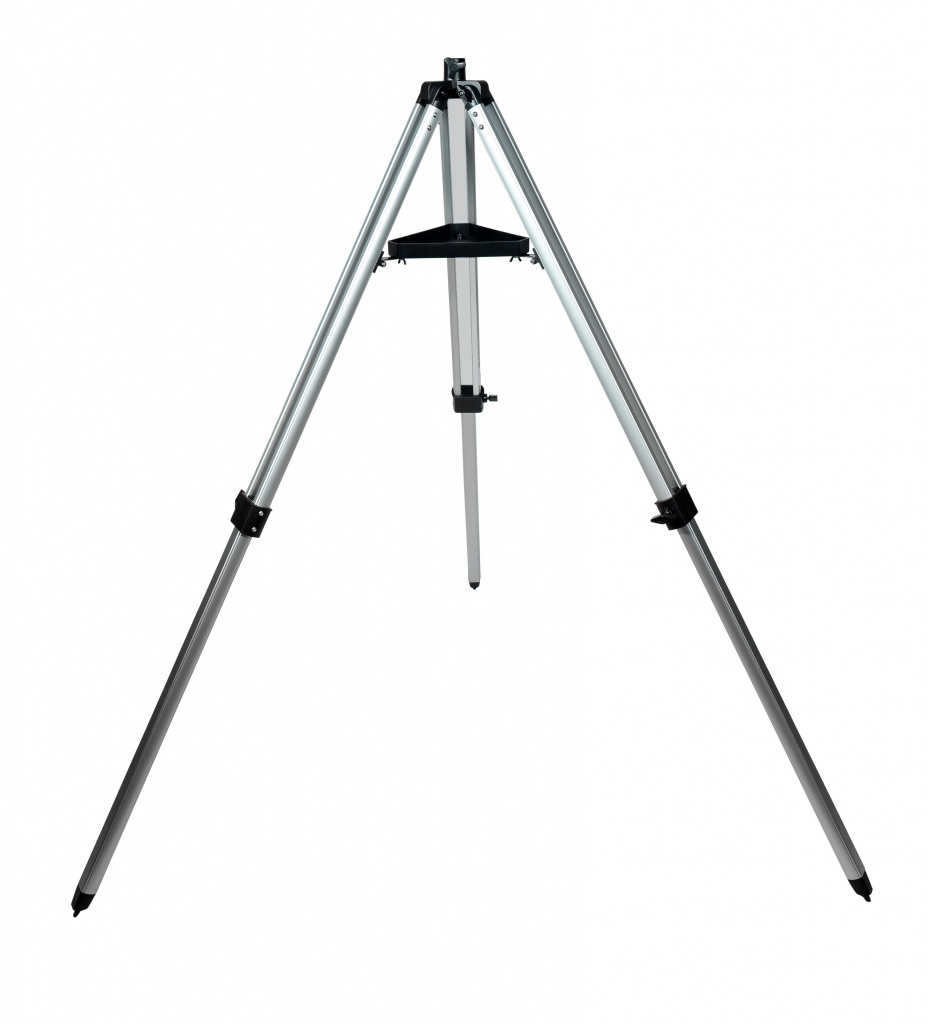 |
First and foremost, it is important to consider certain factors when choosing a telescope.
Optical arrangement
First and foremost, attention must be paid to the optical arrangement of the telescope. They vary in how they present objects. Telescopes can be categorized into three groups:
Refracting telescopes
The construction of refracting telescopes consists of two key components: an objective lens and an eyepiece. Light that passes through the objective lens is refracted and focused.
Refractive telescopes often encounter the issue of chromatic aberration, which refers to color distortions such as the appearance of colored halos around the observed object. The use of advanced lens designs can minimize the occurrence of aberrations. These telescopes feature achromatic or apochromatic lenses, which are characterized by their lens structure (convex or concave).
An achromatic lens typically consists of two lenses with different dispersion. This, along with the presence of an air gap between the lenses, helps to minimize chromatic aberrations.
Apochromatic lenses offer the highest image quality thanks to their specific structure. Apochromats can be made up of anywhere from 3 to 5 lenses, and the arrangement and composition of these lenses contribute to the correction of chromatic aberrations. The exceptional image quality obtained from these telescopes makes them ideal for astrophotography.
Meade offers a range of lenticular telescopes, including entry-level achromatic refractors with apertures ranging from 50 to 120 mm (such as the Adventurer Scope, Infinity, StarPro, StarNavigator, and ETX series) and premium apochromats with apertures ranging from 70 to 130 mm (marked with APO).
What can you observe using refractor telescopes?
Refractor telescopes are excellent for observing various objects within our solar system, such as the Moon and planets. They are also great for observing double stars and terrestrial objects. Additionally, refractors with a lens diameter of 90mm or larger can be used to observe bright deep space objects.
Advantages and disadvantages of refractor telescopes
One of the greatest advantages of refractor telescopes is their reliable and stable optical system, which does not require frequent adjustment. This makes them a great choice for beginners.
Refractors also have the advantage of fast thermal stabilization and their structure helps protect the optics from dust and dirt. They are also relatively lightweight, making them portable and convenient for outdoor activities.
One of the drawbacks is the presence of chromatic aberrations and a small aperture when compared to other optical designs. Achromatic and apochromatic lenses effectively handle aberrations, minimizing them to a minimum.
Reflector Telescopes
Reflector telescopes produce images using mirrors.
Reflectors are available in various systems. The most common one is the Newtonian system. In this design, light is reflected from the primary concave mirror and directed towards a flat secondary mirror, which then reflects the light into the eyepiece located on the side of the tube. Newtonian reflectors, in comparison to other systems, offer the best price-to-light ratio.
It is important to note that the images observed through Newtonian telescopes are inverted. There are special prism devices available for such telescopes to correct this inversion.
During daytime observations with low magnification, the presence of a diagonal mirror can cause interference.
One alternative used in reflectors is the Cassegrain system, which involves a primary mirror that is concave and a secondary mirror that is convex. This traditional Cassegrain system has become less common, with its modifications such as the Doll-Kerkema system and the Ritchie-Cretien system gaining popularity.
The Doll-Kerkema system, on the other hand, utilizes a main elliptical mirror that is simpler than a parabolic mirror, along with a secondary convex spherical mirror. Telescopes equipped with this optical system may exhibit certain aberrations, but if properly assembled, they can still produce high-quality images, making them suitable for astrophotography of planets.
Telescopes utilizing the Ritchie-Cretien optical system are comprised of dual hyperbolic mirrors. They require significant labor during production, but effectively eliminate various aberrations at large apertures. Telescopes employing the Ritchie-Cretien system enable the capture of high-quality astrophotographs.
The Newtonian mirror telescope system is an outstanding option for backyard or outdoor observation. The compact Kassegren mirror is ideal for balcony use.
Mirrored telescopes from Meade are available in the following series: Polaris, EclipseView, LightBridge, and LX85. These series offer aperture sizes ranging from 114mm to 406mm.
What can be observed using reflectors?
Reflectors offer a wide range of possibilities for astronomical observations. They are particularly useful for observing celestial objects such as the Moon and its craters, planets, double stars, star clusters, as well as deep space objects like nebulae, galaxies, and comets.
Pros and cons
One of the main advantages of reflectors is their ability to accommodate larger apertures compared to refractors. This allows for the observation of even faint objects in deep space through reflector telescopes.
Another benefit of reflectors is their ability to eliminate chromatic aberrations and produce bright, clear images.
Reflectors are also known for their compact and portable design, making them convenient for transportation.
However, it’s important to note that reflector telescopes do have some disadvantages, including low contrast, particularly when observing small image details.
The open design of reflectors leaves them vulnerable to dust and dirt, which can be a drawback. Cleaning the mirrors is necessary from time to time, but beginners should be cautious to avoid causing any damage to the mirrors.
Aside from cleaning, occasional adjustments to the mirror’s position (alignment or collimation) may be needed due to factors like transportation, operation, or cleaning.
Reflectors have a different structure compared to refractors, and this affects their ability to stabilize temperature. Unlike refractors, reflectors take longer to cool down under extreme temperature conditions.
Catadioptrics
Catadioptric telescopes employ a combination of lenses and mirrors to form an image and rectify optical distortions. The two most widely used systems in mirror-lens telescopes are the Schmidt-Cassegrain and Maksutov-Cassegrain. Both of these optical systems are based on the Cassegrain configuration.
The Schmidt-Cassegrain system is comprised of spherical mirrors arranged in a similar manner as the Cassegrain system. These mirrors reflect light onto a specialized Schmidt correction plate that corrects the spherical aberrations of both mirrors.
The Maksutov-Cassegrain system also utilizes two spherical mirrors and a correcting lens, specifically a convex-concave lens.
There are also Maksutov-Newton and Schmidt-Newton systems. They have the same size as Newton reflectors (which are larger and heavier than Kassegren telescopes), but they have better aberration control and do not have secondary mirror mounts.
It is important to note that mirror-lens telescopes based on the Cassegrain system (Schmidt-Cassegrain and Maksutov-Cassegrain) can produce a direct, but specular image when using a diagonal mirror. To obtain completely straight images, prisms can be used (at 45° and 90° angles).
There are several series of Meade telescopes with mirror-lenses and apertures ranging from 90 to 406 mm, including the ETX, LS, StarNavigator, LX65, LX85, LX90, LX200, LX600, and LX850.
What can you observe with catadioptric telescopes?
Mirror-lens telescopes have a high enough magnification to observe planets. Catadioptric telescopes with a lens diameter of 250mm or larger are ideal for observing faint stars, formations on the Moon (about 1.5km in size), Saturn’s rings, Titan and Uranus disks, faint galaxies, and more.
Many astrophotographers prefer catadioptric telescopes because of their relatively large focus and compact size, which allows for a scaled image.
Pros and Cons
Catadioptrics offer smaller dimensions compared to telescopes from other groups, while maintaining a similar relative aperture.
Mirror-lens telescopes deliver outstanding image quality and minimal aberrations of any kind. However, they often come with a high price tag.
These telescopes are suitable for observing both objects within our solar system and deep space objects.
The front of a catadioptric telescope is sealed with a corrector or miniscope, providing protection against dust, grass, and air currents. However, this also prolongs the thermal stabilization time.
A major drawback is the complexity of independently adjusting the telescope. Even some professionals struggle with adjusting catadioptrics on their own.
Aperture size
Next, when selecting a telescope for a child or an amateur astronomer, it is essential to consider the size of the objective lens, also known as the aperture. The aperture refers to the part of the telescope that captures light and directs it towards the focal point. A larger aperture allows for a greater amount of light to be gathered, resulting in a more vibrant and sharper image. The size of the aperture directly influences the level of detail visible in the observed image. Therefore, the aperture, rather than the maximum magnification, holds primary significance when it comes to telescopes. It is worth noting, however, that telescopes with larger apertures tend to be more expensive and bulkier in size.
Telescopes ranging in aperture size from 50 to 150 mm are ideal for those who are just starting to explore the wonders of outer space. It is important to take into account the surrounding environment when planning your observation sessions. In urban areas, there is often a significant amount of light pollution, so telescopes with an aperture size of 70 to 90 mm are more suitable for observing in such conditions. This range of aperture is sufficient for observing objects within our solar system, as well as nearby stars, planets, and satellites.
Concentration and brightness
Concentration and brightness are two other important factors in achieving a high-quality image.
Concentration, also known as focal length, refers to the distance between the lens (or main mirror) and the point where the collected rays converge. Focal length impacts the range of astronomical observations. However, it is not always true that a larger focal length is better. Increasing the focal length can result in a decrease in the observed image’s diameter.
Aperture, or relative aperture, is the ratio between the focal length and the lens diameter. The aperture value determines the telescope’s ability to gather light. A higher aperture value enables the observation of dimmer objects.
These two parameters are interconnected and have an impact on the quality of the image obtained during observations. It is important to note that increasing the focal length results in a decrease in the diameter of the observed image and also reduces the brightness.
Mounting
It is essential not to overlook the mounting of the telescope tube. The two most common types of mounts are azimuthal and equatorial mounts.
An azimuthal mount allows for the rotation of the telescope along two axes (vertical and horizontal). This mount operates similarly to a conventional tripod.
An equatorial mount is aligned with the celestial coordinate system and enables movement of the telescope along just one axis.
When selecting a telescope with a particular mount, it is important to consider its size and weight.
Telescopes on an azimuthal mount are a better option for amateur observations. They offer a simpler and more intuitive design, making it easier for beginners to set up the telescope and start observing.
Now, let’s explore a few MEADE telescopes that are perfect for beginner astronomers.
MEADE Infinity 70mm Telescope
The MEADE Infinity 70mm telescope is an excellent choice for aspiring astronomy enthusiasts or children. It is lightweight, yet sturdy, making it easy to transport and use during trips.
With a focal length of 700mm, a relative aperture of f/10, and an aperture of 11.3 magnitudes, the MEADE Infinity 70mm telescope allows you to observe celestial objects such as Saturn, Jupiter, Mars, the Orion Nebula, and more.
The telescope comes with two eyepieces and a wraparound prism, which enhance the possibilities for both astronomical and terrestrial observations. To facilitate the quick search of objects, a red dot seeker is installed on the telescope tube.
MEADE Polaris 90mm Telescope
The 90mm achromatic refractor telescope features a lens diameter of 90mm and comes with an equatorial mount that can be adjusted in height. The objective lenses are coated with an enlightening coating to provide brighter and more contrasty images of both astronomical and terrestrial objects.
This refractor telescope has a long focal length of 1000mm and is highly recommended for novice astronomy enthusiasts or children. It is user-friendly and reliable, making it suitable for long trips.
The Equatorial mount offers great convenience for observing celestial objects, particularly for effectively tracking their diurnal movement, although it may require some effort to set up and mount. To facilitate quick searching, a red dot finder is attached to the telescope tube.
With a maximum magnification of 180x, a relative aperture of f/11.1, and an aperture of 12.3 magnitudes, the MEADE Polaris 90mm telescope is an excellent choice for observing various astronomical wonders. It is well-suited for studying the Moon’s seas and craters, Jupiter, Saturn’s rings, bright star clusters, nearby galaxies, and nebulae.
The MEADE Polaris 114mm Telescope
The MEADE Polaris 114mm Telescope is a lightweight Newton reflector telescope that features a 114mm objective lens diameter. This lens diameter ensures that you can see bright and contrasting images of thousands of objects in the night sky. Whether you’re a beginner or an experienced astronomer, this telescope is perfect for observing celestial bodies.
One of the standout features of this telescope is its equatorial mount with adjustable leg height. This mount allows you to easily track the movements of celestial bodies, making it easier to observe and study them. While the equatorial mount may pose some challenges for novice astronomers when it comes to installation and adjustment, it is well worth the effort for the benefits it provides.
In addition to the equatorial mount, the MEADE Polaris 114mm Telescope also comes equipped with a red dot finder. This finder is a handy tool that helps you quickly locate and target specific objects in the night sky. With this feature, you can spend less time searching and more time observing.
The MEADE Polaris 114mm telescope boasts a focal length of 1000mm, an f/8.8 relative aperture, and a 12.8 star magnitude aperture. With these specifications, you can marvel at the majestic rings of Saturn, the intricate cloud belts of Jupiter, the iconic Great Red Spot, the polar caps of Mars, the dazzling Pleiades cluster stars, and a host of other celestial wonders.
This equatorial mount reflector, with its impressive focal length, is not only ideal for beginners but also highly recommended for seasoned astronomy enthusiasts. Its versatility makes it the perfect gift, even for a child. Thanks to the Newton optical design, chromatic aberrations are nonexistent, resulting in crystal-clear and vibrant images.
MEADE Polaris 127mm telescope
The MEADE Polaris 127mm telescope is a Newton reflector with a compact shortened tube and a large lens diameter of 127mm. It is slightly heavier compared to the telescopes mentioned above. This telescope comes with a red dot finder, three eyepieces, a Barlow lens, and a reinforced equatorial mount with adjustable leg height.
Installing and setting up the equatorial mount may initially seem difficult for beginners, but once it is re-installed, there are usually no further difficulties.
Thanks to its Newton optical scheme, the MEADE Polaris 127mm telescope is free from chromatism, allowing you to see clear images without any colored halos around bright stars and the Moon.
The telescope has a maximum magnification of 254x, a relative aperture of f/7.9, and a permeability of 13. With these specifications, you will be able to observe various celestial objects such as Saturn’s rings, cloud belts, Jupiter’s Great Red Spot, the polar caps of Mars, scatterings of stars in the Pleiades cluster, NGC 869, and more.
The MEADE Polaris 127mm telescope is suitable for both beginner astronomers (children and adults) and advanced amateur astronomers.
We have provided information on the key features to consider when selecting a telescope and have chosen a few models that are ideal for starting out in stargazing.
When selecting a telescope for yourself, your child, or your friends, it is important to ask yourself a few questions:
- What types of observations will the telescope be used for?
- Do you have the willingness to perform the tuning and cleaning of the internal components of the telescope?
- What is your expected budget for the telescope?
By providing answers to these queries and going through our article, you can already gain an understanding of your requirements.
We hope you have clear skies and successful observations!
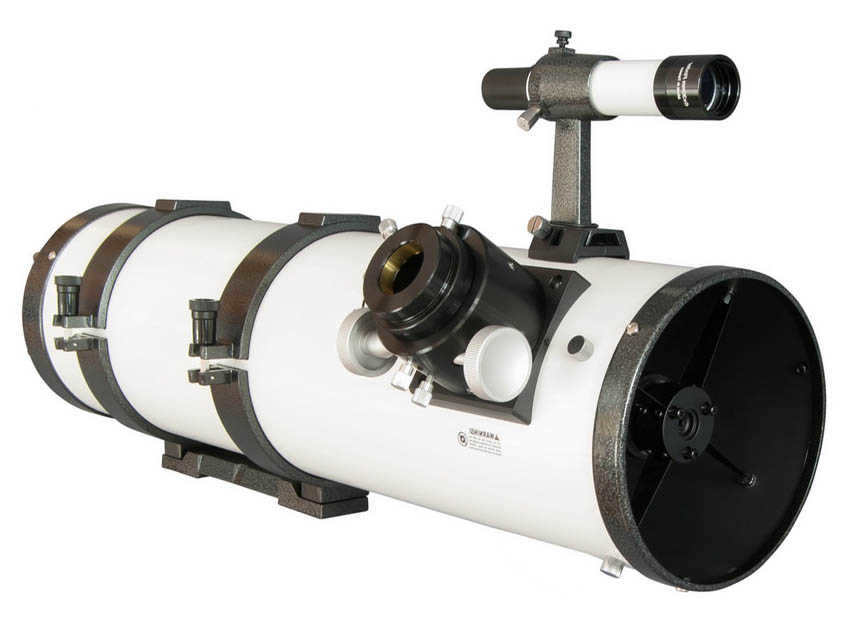
When it comes to stores that cater to astronomers, you’ll find a wide range of equipment options available.
Each telescope model has its own unique features, making it important to understand and compare the different options before making a purchase. To start off, let’s answer the question: what exactly is a Newton reflector?
Overview of the Newtonian Reflector Telescope
The Newtonian reflector is a widely popular telescope system in use today. It is utilized by manufacturers for both amateur and professional devices due to several key reasons.
Firstly, the manufacturing process for these reflectors is relatively simple. Additionally, they have a reputation for being durable and low-maintenance. Finally, telescopes equipped with Newtonian reflectors are more cost-effective compared to those with lenses.
Types of Reflectors
Generally, in this type of device, the main lens is substituted with the main mirror. This mirror is responsible for gathering light from the observed objects during its use. As a result, this device is commonly referred to as “Newton’s mirror telescope”. However, there is another category of reflector known as Dobsonian instruments. These models are equipped with a lightweight and simple mount. Due to their minimal weight, the finished telescopes are not only lightweight and compact, but also highly portable, while still providing a convenient lens for observation.
It should be noted that Dobsonian devices are primarily designed for visual observations. If an astronomer requires a more advanced instrument that not only allows for viewing celestial objects, but also capturing them through photography, then an equatorial mount is necessary in this case.

